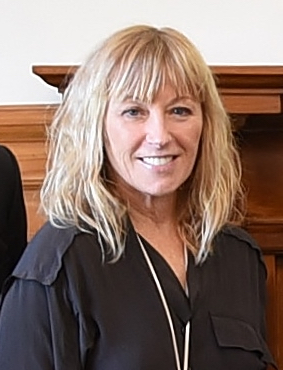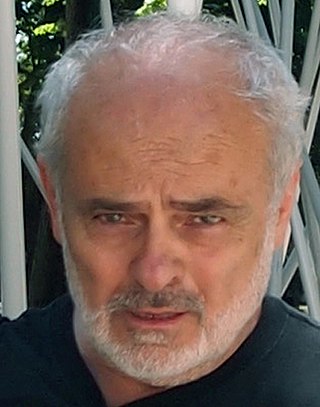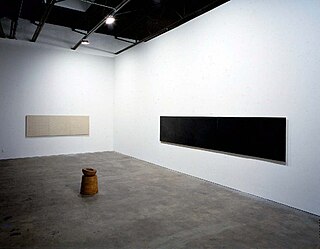Related Research Articles
Barbara Kruger is an American conceptual artist and collagist associated with the Pictures Generation. She is most known for her collage style that consists of black-and-white photographs, overlaid with declarative captions, stated in white-on-red Futura Bold Oblique or Helvetica Ultra Condensed text. The phrases in her works often include pronouns such as "you", "your", "I", "we", and "they", addressing cultural constructions of power, identity, consumerism, and sexuality. Kruger's artistic mediums include photography, sculpture, graphic design, architecture, as well as video and audio installations.

Cynthia Morris Sherman is an American artist whose work consists primarily of photographic self-portraits, depicting herself in many different contexts and as various imagined characters.

Robert Longo is an American artist, filmmaker, photographer and musician.

Hallwalls Contemporary Arts Center is a non-profit art organization located in Buffalo, New York. Since 1974, Hallwalls has shown and shows the work of contemporary artists of diverse backgrounds who work in film, video, literature, music, performance, media and the visual arts. The ideology behind Hallwalls has always been one of a cooperative with artists and the gallery has made it a mission to show work that directly shows Buffalo’s fading industrial past.

The Fisher Landau Center for Art is a private foundation located in Long Island City, in Queens, New York City, United States. It offered regular exhibitions of contemporary art, open to the public from 12 to 5 pm, Thursdays through Mondays, until it closed to the public in November 2017.

The Burchfield Penney Art Center, or just the Burchfield Penney, is an arts and educational institution part of Buffalo State University, located adjacent to the main campus in Buffalo, New York, United States. Dedicated to the art and vision of American painter Charles E. Burchfield, it was founded in 1966 as the Charles E. Burchfield Center. The center features a museum, library, and activity space for the arts. It maintains the world's largest collection of Burchfield's work, as well as many other distinguished artists of Buffalo, Niagara and Western New York. It is engaged with every aspect of Buffalo and the region's rich cultural activity.

Joshua Neustein is a contemporary visual artist who lives and works in New York City. He is known for his Conceptual Art, environmental installations, Land Art, Postminimalist torn paper works, epistemic abstraction, deconstructed canvas works, and large-scale map paintings.

Thomas Lawson is an artist, writer, editor, and from 1991 to 2022 was the Dean of the School of Art & Design at California Institute for the Arts. He emerged as a central figure in ideological debates at the turn of the 1980s about the viability of painting through critical essays, such as "Last Exit: Painting" (1981). He has been described as "an embedded correspondent [and] polemical editorialist" who articulated an oppositional, progressive position for representational painting from within an increasingly reactionary art and media environment. Artforum called his approach to the medium "one of the most cogent and controversial" in the 80s.

Gloria Graham is an American artist based in New Mexico. Her work includes sculpture, painting, and photography.
Charles Sidney Clough is an American painter. His art has been exhibited in over 70 solo and over 150 group exhibitions throughout North America and Europe and is included in the permanent collections of over 70 museums, including the Metropolitan Museum of Art, National Gallery of Art, and Smithsonian American Art Museum. Clough has received fellowships and grants from the New York State Council on the Arts, National Endowment for the Arts, Adolph and Esther Gottlieb Foundation, the Pollock-Krasner Foundation, and the John Simon Guggenheim Foundation.
The Pictures Generation, 1974–1984 was an exhibition at The Metropolitan Museum of Art in New York City that ran from April 29 – August 2, 2009. The exhibition took its name from Pictures, a 1977 five person group show organized by art historian and critic Douglas Crimp (1944–2019) at New York City's Artists Space gallery. The artists exhibited from September 24 to October 29, 1977 were Troy Brauntuch, Jack Goldstein, Sherrie Levine, Robert Longo and Philip Smith.

Bonnie Collura is an American artist known for figurative multi-media sculptures, textiles and installations created by processes of compositing and sampling. Her art oscillates between abstraction and figuration, mixing aesthetics from baroque sculpture, contemporary animation and quilting with iconic fragments from pop culture, art history and myth. She has embraced theatricality and excess, intertextuality and digital-age influences in her work, often exploring hybridized, disjointed bodies, surrogate characters and reconfigured literary tropes. Sculpture critic Ann Landi has written, "Collura incorporates wildly diverse materials and processes while also drawing on a wide array of references—everything from cartoons and movies like Star Wars to highbrow texts such as The Prince and Frankenstein … Diffuse and open-ended, appealing to storytelling and world-making, her work continues to evolve, carrying on a feminist tradition in its materials and mythologies."
Barbara Bloom lives and works in New York City. She is a conceptual artist best known for her multi-media installation works. Bloom is loosely affiliated with a group of artists referred to as The Pictures Generation. For nearly twenty years she lived in Europe, first in Amsterdam then Berlin. Since 1992, she has lived in New York City with her husband, the writer-composer Chris Mann, and their daughter.
Michael Zwack was an American artist most often associated with The Pictures Generation.
Robert Pincus-Witten was an American art critic, curator and art historian.

Annette Lemieux is an American artist who emerged in the early 1980s along with the "picture theory" artists. Lemieux brought to the studio a discipline equally based on introspection, and the manifestations of an ideological minimalism. Process is a key component in the execution of her works over the past three decades, creating the lure to the confrontation of issues of social and historical urgency. Lemieux has been the recipient of awards from the National Endowment of the Arts and the Keiser Wilhelm Museum, Germany and an honorary Doctorate in Fine Arts from Monserrat College of Art. Presently, in addition to her studio and exhibition schedule, she is a senior lecturer at Harvard University in the area of visual and environmental studies.
Jennifer Bolande is an American postconceptual artist whose work employs various media—primarily photography, sculpture, film and site-specific installations in which she explores affinities between particular sets of objects and images and the mercurial meanings they manufacture.
Gretchen Bender was an American artist who worked in film, video, and photography. She was from the so-called 1980s Pictures Generation of artists, which included Cindy Sherman, Robert Longo, Jack Goldstein, Laurie Simmons and Richard Prince, and who mixed elements of Conceptual Art and Pop Art using images from popular culture to examine its powerful codes.

Gerry Hayes is an American painter who in addition to his paintings, has created installation sculpture and conceptual ideas documented in photography.

Constance DeJong is an American visual artist who works in the margin between sculpture and painting/drawing. Her predominate medium is metal with light as a dominant factor. She is currently working in New Mexico and is a professor of sculpture at the University of New Mexico. DeJong received a National Endowment for the Arts Visual Art Fellowship in 1982. In 2003, she had a retrospective at the Albuquerque Museum of Art and History. That same year, Constance DeJong: Metal was published and released by University of New Mexico Press. Her work has been described by American art critic Dave Hickey as "work worth seeing and thinking about under any circumstances".
References
- ↑ Sandra Gering. "Nancy Dwyer" . Retrieved 18 April 2014.
- ↑ Cotter, Holland (April 23, 2009). "At the Met, Baby Boomers Leap Onstage". New York Times. Retrieved 18 April 2014.
- ↑ Dwyer, Nancy. "Info" . Retrieved 18 April 2014.
- ↑ Eklund, Douglas (2009). The Pictures Generation, 1974-1984. Metropolitan Museum of Art. p. 143.
- ↑ Pincus-Witten, Robert (April 2013). "NANCY DWYER: FISHER LANDAU CENTER FOR ART". Artforum.
- ↑ Tomkins, Calvin (2010). Lives of the Artists: Portraits of Ten Artists Whose Work and Lifestyles Embody the Future of Contemporary Art (reprint). Macmillan. p. 30.
- ↑ "EXHIBITION: "Hallwalls: 5 Years"". New Museum Digital Archive. Retrieved 18 April 2014.
- ↑ "Nancy Dwyer". New Museum Digital Archive.
- ↑ "Nancy Dwyer". Sandra Gering Inc.
- ↑ "Laughter Ten Years After". Belkin Art Gallery, UBC. Retrieved 18 April 2014.
- ↑ Johnson, Ken (March 21, 2013). "Nancy Dwyer: 'Painting and Sculpture, 1982-2012'". New York Times. Retrieved 18 April 2014.
- ↑ Pincus-Witten, Robert (April 2013). "Nancy Dwyer: Fisher Landau Center for Art". Artforum.